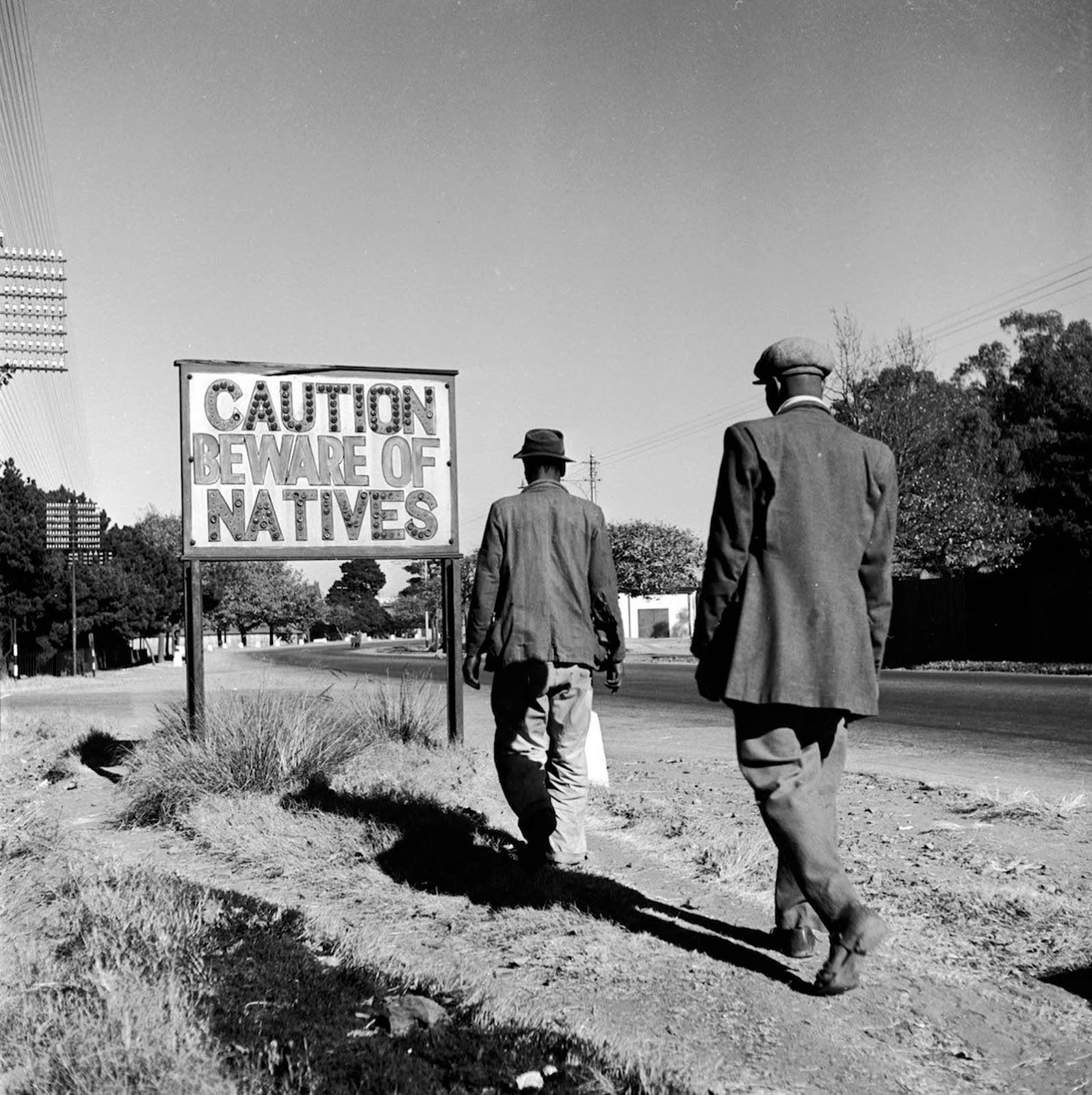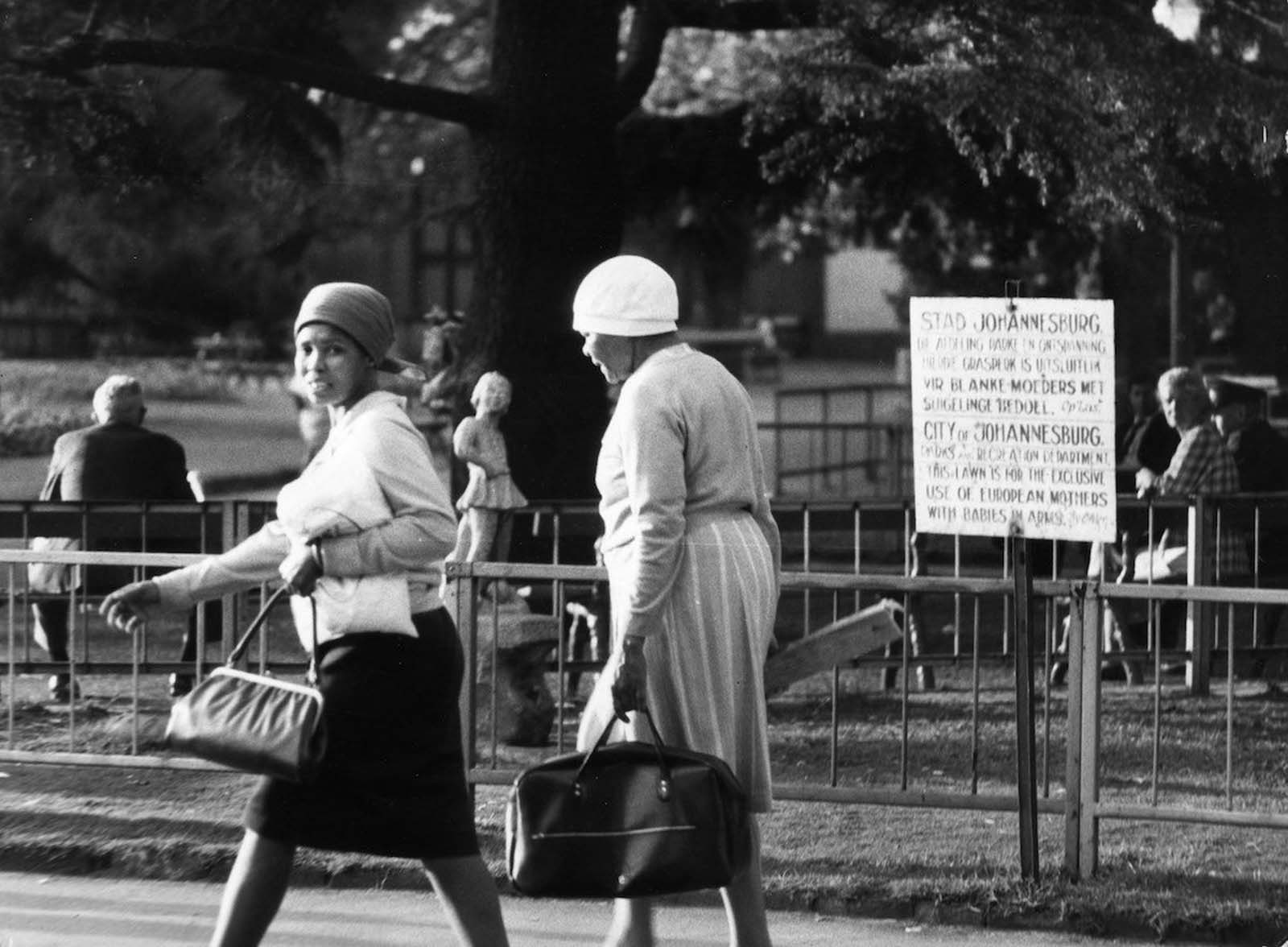
A sign common in Johannesburg. 1956.
There are few words more closely associated with 20th-century South African history than apartheid, the Afrikaan word for “apartness” that describes the nation’s official system of racial segregation.
And though the discriminatory divide between whites of European descent and black Africans stretch back to the era of 19th-century British and Dutch imperialism, the concept of apartheid did not become law until 1953, when the white-dominated parliament passed the Reservation of Separate Amenities Act.
This act officially segregated public spaces such as taxis, ambulances, hearses, buses, trains, elevators, benches, bathrooms, parks, church halls, town halls, cinemas, theaters, cafes, restaurants, hotels, schools, universities—and later, with an amendment, beaches, and the seashore.
Apartheid is often loosely divided into two parts: petty and grand apartheid. These South African signs shown in this article are examples of what was known as Petty Apartheid.
Petty Apartheid was the most visible side of Apartheid. It was the segregation of facilities based on race. Grand Apartheid refers to the underlying limitations placed on black South Africans’ access to land and political rights.
These were the laws that prevented black South Africans from even living in the same areas as white people. They also denied black Africans political representation, and, at its most extreme, citizenship in South Africa.

A woman sat in the wagon reserved for White people to protest against Apartheid. 1952.
The core of the Apartheid system was the division of people into racial groups using a complex and trivial series of tests. The result was the classification of the population into one of four groups: White, Black, Indian and Colored, with Colored and Indian groups, further subdivided. (The group names are capitalized here to indicate their use under Apartheid.)
The “pencil test” decreed that if an individual could hold a pencil in their hair when they shook their heads, they could not be classified as White. The tests were primarily based on appearance — skin color, facial features, appearance of head (and other) hair.
Most infamously, the “pencil test” decreed that if an individual could hold a pencil in their hair when they shook their heads, they could not be classified as White. The tests were so imprecise that members of an extended family could be classified into different racial groups.
Every year people were reclassified. In 1984, for example, 518 Colored people were defined as White, two Whites were called Chinese, one White was reclassified as Indian, one White became Colored, and 89 Colored people became Black.
For political, diplomatic, and economic reasons, certain groups and their descendants, including Japanese, Taiwanese, and South Korean immigrants, were classified as “honorary White.” Only the White group could live free of any restrictions. All other racial groups suffered the laws of Petty Apartheid.

White children paddling in a pond marked by a sign reading “For European Children Only.” 1956.
As these signs showed, the restrictions intruded into all aspects of life. While Colored and Indian groups had access to some privileges, the sharpest distinction was between Black and White. The 1953 Separate Amenities Act of 1953 stated that separate facilities no longer had to be “substantially equal.”
The result: Black-only bus stops serviced inferior Black-only buses. Black-only ambulances stopped at inferior Black-only hospitals. Black-only education was provided at inferior Black-only schools and universities. Beaches, bridges, swimming pools, washrooms, cinemas, benches, parks, and even burial grounds were all segregated.
There were a handful of places where segregation didn’t occur, notably drug-dealing nightclubs and churches. Though the lack of segregation in churches was not for want of trying. Blacks could not attend White churches under the 1957 Churches Native Laws Amendment Act, but the law was largely unenforced.
South African President P.W. Botha began to tear down Petty Apartheid in the late 1970s and early 1980s. But while the outward — and literal — signs of Apartheid started to be removed under Botha, the level of brutality against Blacks increased.
Following the end of the Apartheid system in 1994, Botha was found responsible for gross violations of human rights under the nation’s Truth and Reconciliation Commission. He maintained he had no regrets.

Signs in English and Afrikaans, in Wellington railway station, South Africa, enforcing the policy of apartheid or racial segregation. 1955.

Signs in both English and Afrikaans in Johannesburg. 1957.

A bench in Albert Park, Durban. 1960.

A Taxi rank for white people. 1967.

A sign outside a park restricts its use to ‘European mothers with babies in arms’. 1971.

An apartheid notice on a beach near Cape Town. 1974.

An apartheid notice on a beach near Cape Town. 1976.

A rail wagon with the words ‘Non-Whites’. 1978.

A railway carriage reserved for white people only. 1982.

Toilets restricted to use by “Black, Coloreds & Asians” at a bus station. 1986.

Whites only sign in foreground at restricted beach, with bathers in background. 1986.

A sign reading ‘Bathing area for Whites Only’ on a beach at Victoria Bay, Western Cape. 1988.
(Photo credit: The LIFE Images Collection).